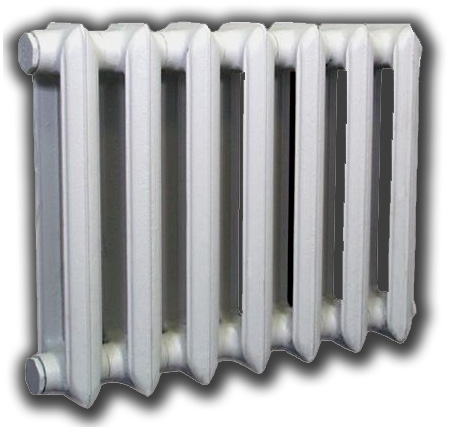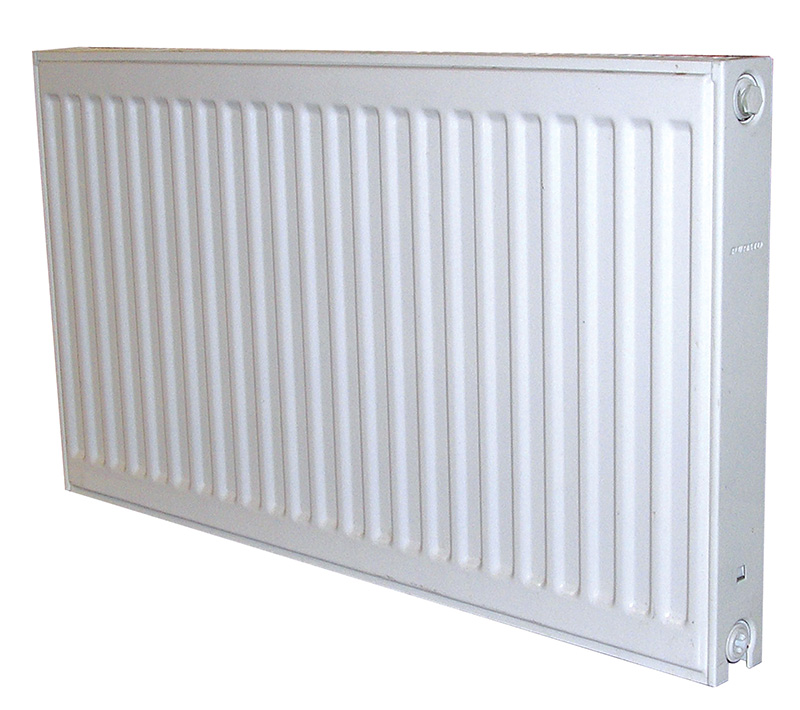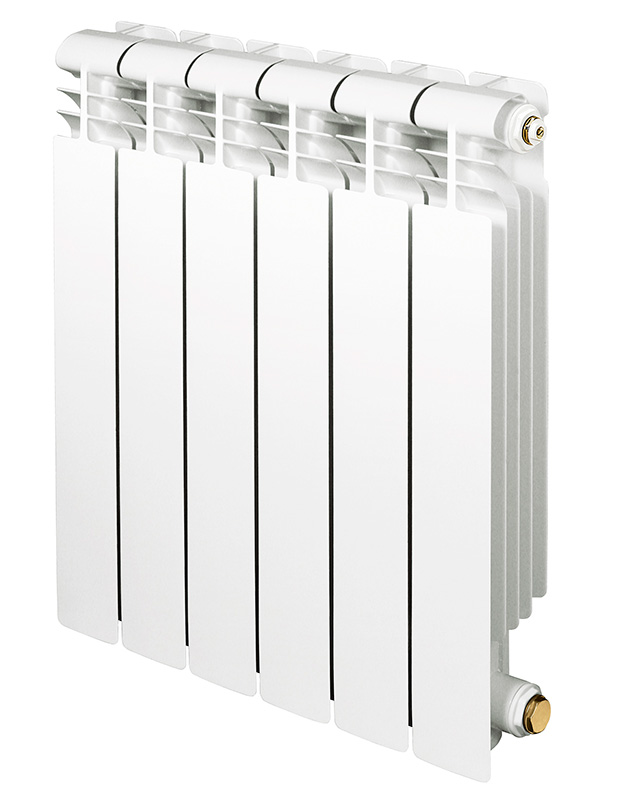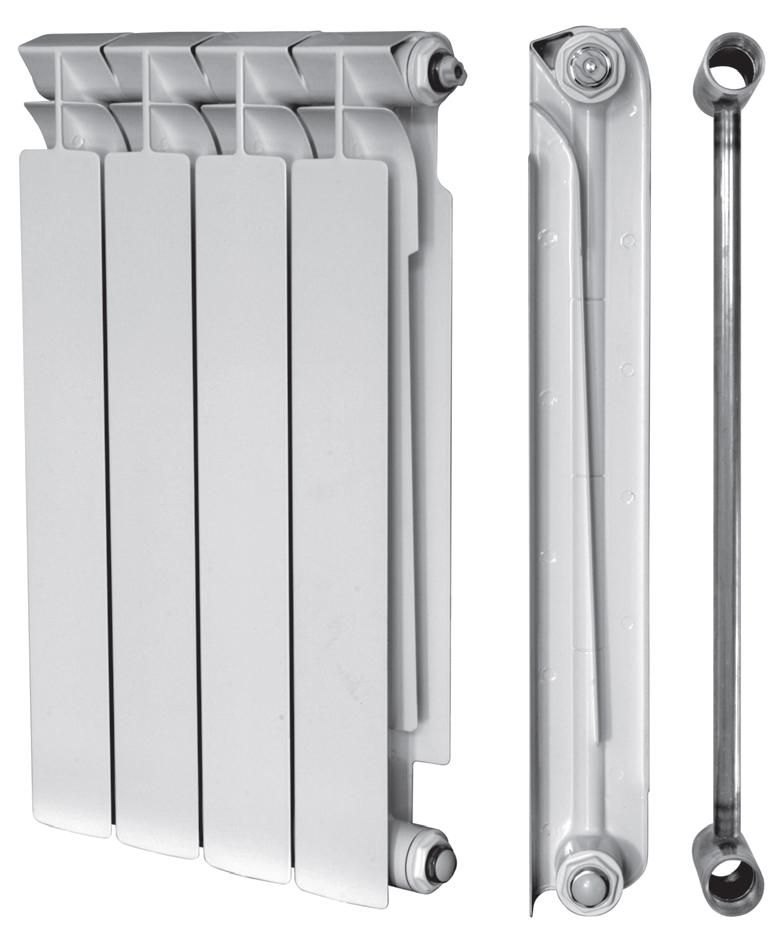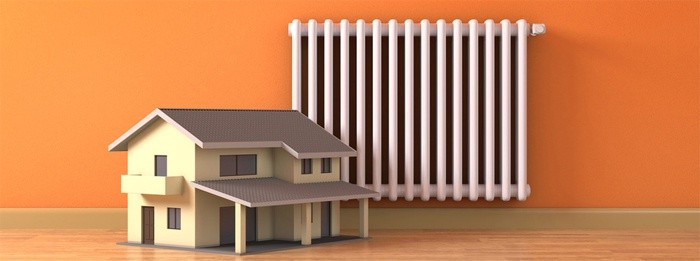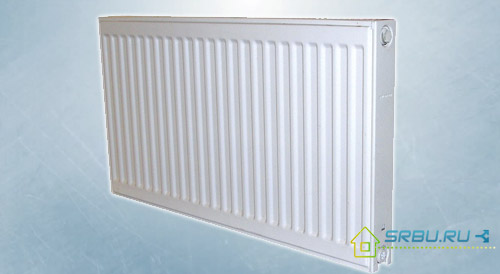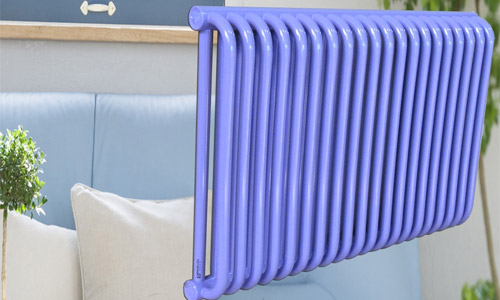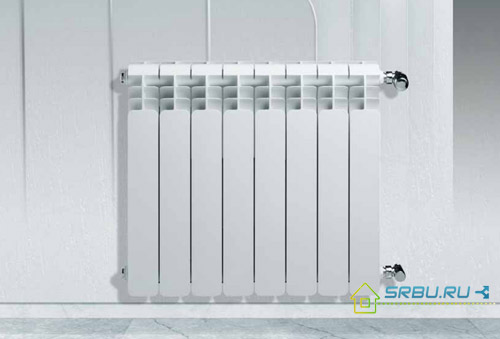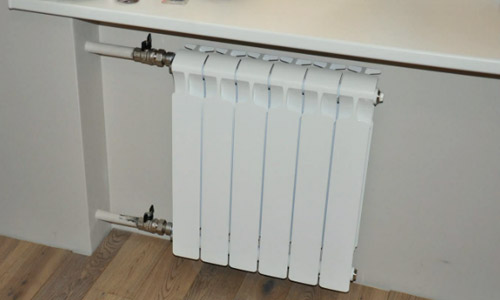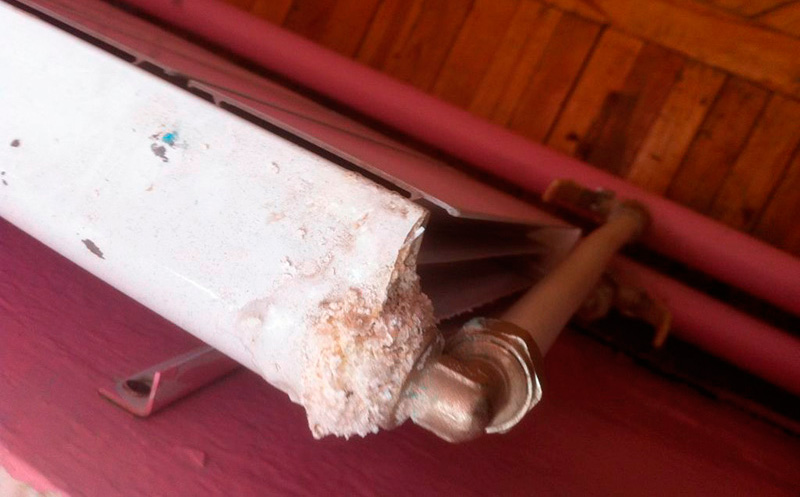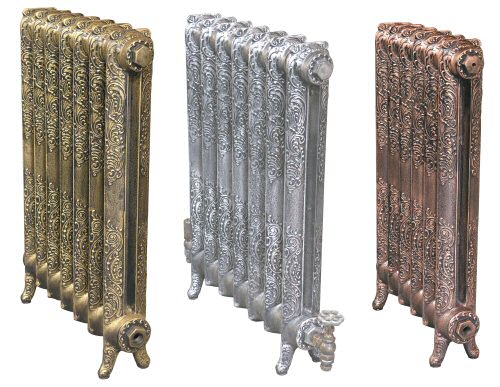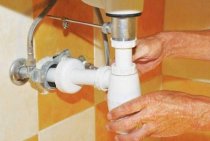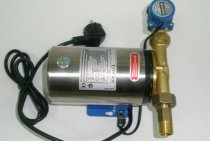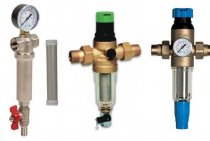Dimensions and design
Metal batteries are a one-piece product, so heat transfer directly depends on their size and quantity. Each additional panel increases the thermal power of the device by 40-50%. Another factor affecting heating efficiency is convection finning.
On the market there are panel radiators of the following types:
- One heating panel without fins (designated as type 10).
- One panel with fins (type 11).
- Two panels without fins (type 20).
- Two panels with one convection fin (21 types).
- Both panels are ribbed (type 22).
- Three-panel are available only in 33 and 30 types.
The first digit in the designation indicates the number of heating panels, the second - the number of convection fins.
The length of the heaters is from 400 mm to 3000 mm in 10 cm increments, and the height of the standard models is from 200 mm to 900 mm.
Metal radiators do not differ in a variety of designs, at the same time, some manufacturers produce models with a smooth front surface (German manufacturer Kermi Plan or Finnish Purmo, Planora series), or with wide flow channels.
Radiators Zehnder (Switzerland) or radiators Arboniya (Germany-Switzerland) tubular type have a wide choice of options, but the cost of such products is high. Russian-made tubular heating radiators are more affordable (KZTO radiator, Sunerzha and others), the average prices for which are lower than the cost of foreign analogues.
Manufacturers
Aluminum heating radiators are produced by both foreign and domestic manufacturers. Let's note some of them.
Faral
The products of this Italian company are very popular, they are of high European quality and have a lot of positive user reviews.
Consider the main parameters of the models offered by Faral.
| Model | Center distance, mm | Height, width, section depth, mm | Max. working pressure, Bar | Thermal power, W | Section volume, l | Weight, kg |
|---|---|---|---|---|---|---|
| GREEN HP 350 | 350 | 430/80/80 | 16 | 136 | 0,26 | 1,12 |
| GREEN HP 500 | 500 | 580/80/80 | 16 | 180 | 0,33 | 1,48 |
| TRIO HP 350 | 350 | 430/80/95 | 16 | 151 | 0,4 | 1,23 |
| TRIO HP 500 | 500 | 580/80/95 | 16 | 212 | 0,5 | 1,58 |
Radiator Faral Trio HP 500/100
Rovall
This manufacturer is also from Italy. Extruded aluminum pipes are used in the production of radiators. The market offers a wide range of colors for radiators. The most famous Rovall models: TANGO, OPERA, ALUX, JAZZ, BLUES, SWING.
| Model | Center distance, mm | Height, width, section depth, mm | Max. working pressure, Bar | Thermal power, W | Section volume, l | Weight, kg |
|---|---|---|---|---|---|---|
| ALUX 200 | 200 | 245/80/100 | 20 | 92 | 0,11 | 0,83 |
| ALUX 350 | 350 | 395/80/100 | 20 | 155 | 0,11 | 0,82 |
| ALUX 500 | 500 | 545/80/100 | 20 | 179 | 0,23 | 1,31 |
Fondital
An Italian manufacturer, the company's products are designed specifically for the operating conditions of Russia and the CIS countries. Fondital aluminum radiators are manufactured in accordance with high European quality standards, while complying with Russian standards (GOST R RU.9001.5.1.9009).
| Model | Center distance, mm | Height, width, section depth, mm | Max. working pressure, Bar | Thermal power, W | Section volume, l | Weight, kg |
|---|---|---|---|---|---|---|
| Calidor Super 350/100 | 350 | 407/80/97 | 16 | 144 | 0,24 | 1,3 |
| Calidor Super 500/100 | 500 | 557/80/97 | 16 | 193 | 0,30 | 1,32 |
Rifar
Domestic manufacturer, which is in no way inferior in quality to foreign counterparts. Reviews for Rifar products are positive. Users note the attractive design of radiators and high efficiency.
| Model | Center distance, mm | Height, width, section depth, mm | Max. working pressure, Bar | Thermal power, W | Section volume, l | Weight, kg |
|---|---|---|---|---|---|---|
| Alum 350 | 350 | 415/80/90 | 20 | 139 | 0,19 | 1,2 |
| Alum 500 | 500 | 565/80/90 | 20 | 183 | 0,27 | 1,45 |
Aluminum radiator RIFAR Alum 500 5 sections
Based on the above, we can conclude that aluminum heating radiators are an excellent source of heating, especially for private houses. Due to the large number of positive aspects and high technical performance, coupled with a low price, it makes such batteries very attractive to users. As a result, the high demand of users is justified.
Simple, but very aesthetic design allows you to fit aluminum radiators into any interior. Appliances are not only a high-quality and economical source of heating, but also occupy a worthy place in the interior.
The normal operation of heating radiators for an apartment in a multi-storey building depends on a number of important factors, where the duration of use, determined by each specific manufacturer, plays an important role. Based on the material of production, various batteries can last from 15 to 35 years.
In view of the fact that installing new batteries in an apartment is a long-term investment, when choosing devices for equipping an apartment heating system, you should ask how long devices of a certain type last and what can affect their durability!
Who should change batteries is the responsibility of the parties, heating repair
As a result, the homeowner buys and replaces the battery on his own, providing heat in the house.
ATTENTION! In the event that the owner of the apartment repairs the heating system on his own, he may demand compensation in the amount of the cost of the radiator. Unfortunately, it is difficult to achieve this compensation even through the court, the management company finds arguments in its defense.
Therefore, it is better to first consult with an experienced lawyer when it is possible to present an invoice to the Criminal Code before starting a controversial case.
The main features of the process During operation, the batteries wear out, for better operation of the heating system, they need to be replaced. But radiators, as common house property, at whose expense to change the premises of the apartment.
The management company may not consider such work necessary, and according to the law, the possibilities for self-repair of common house property are limited.
At whose expense is the replacement of the heating battery in the apartment through the housing office
Who owns the heating radiators within the apartment, who is responsible for their work - homeowners or housing and communal services? Content
- 1 Legislative solution to the issue of property
- 2 Changing a radiator in a council house
- 3 Who is replacing?
- 4 Main features of the process
- 5 How do I get permission?
- 6 The management company refuses to change radiators - what should residents do?
- 7 Key recommendations
- 8 Useful video
Legislative decision on the issue of ownership Are the batteries common property or is it private property for which the owner is responsible? The Government approved Decree No. 491 dated 13.08.06, which provides a list of property common to residents of an apartment building.
Which radiators to choose for heating an apartment
Which heating radiators are better to choose for your apartment? The choice of consumers are cast-iron radiators, steel, aluminum and bimetallic. Let's try to figure out how they differ from each other and which ones are best suited for an apartment installation.
Cast iron radiators
These are the oldest radiators on the market for heating equipment. They differ in solid dimensions, as they are made of thick cast iron. Such radiators withstand pressure drops, withstand water hammer and high temperatures. They are also able to work with aggressive coolant. Everything would be fine, but they are characterized by low heat dissipation, which makes them somewhat unsuitable for use in cold regions.
Their disadvantages also include:
- Inconvenience in installation - high weight affects;
- Not too attractive external data;
- Not suitable for use in high-rise buildings (above 5-9 floors).
Otherwise, these are good radiators, hardy and strong. Recently, quite modern models have appeared on the market, which have acceptable dimensions and a decent appearance. And they can be mounted in low-rise buildings, where they will serve for many years.
Steel radiators
Looking at modern steel panel radiators, you immediately begin to understand that they obviously cannot withstand a lot of pressure. And this is true, because thin metal is used here, which is not distinguished by expressive durability.Steel radiators can be useful for heating small private houses or summer cottages, but they are not suitable for use in high-rise buildings.
The only exceptions are some models of steel radiators. through which relatively thick pipes pass - their endurance is somewhat higher. Often they are called tubular radiators. Today they are found in some houses with a height of 9-16 floors.
Steel radiators are characterized by high heat dissipation and heat the premises well. They are also very light and easy to install. The undoubted advantage is the small internal volume. But all these advantages become useless if you need to install these radiators in an apartment - they will still serve in low-rise buildings (the use of tubular models is required), but in high-rise buildings they will not withstand high pressure.
Aluminum radiators
Modern aluminum radiators are characterized by low weight and high heat dissipation. Yes, aluminum itself is a fairly strong metal. Radiators made of it are ready to withstand the high pressure of the coolant, but there is no resistance to water hammer. No less negative is the lack of resistance to the effects of the coolant - aggressive impurities literally corrode such radiators, leading to ruptures and leaks.
The appearance of aluminum radiators captivates with its splendor - they are compact and neat, they are easy and pleasant to install, but the lack of resistance to water hammer and corrosion spoils everything. But they can be an excellent solution for private households.
Sometimes it is allowed to use aluminum radiators in low-rise buildings, where the coolant pressure is not as high as in high-rise buildings. They are also successfully used in apartments with individual heating.
Bimetal radiators
If you do not know which heating radiators are better to install in an apartment, then we recommend that you turn your attention to bimetallic models. Inside them we will find:
- Steel base - it withstands pressure up to 50 atmospheres and resists corrosion well;
- The aluminum body, not in contact with the coolant, provides simply excellent heat dissipation.
Bimetallic radiators are not afraid of water hammer and high pressure, they are easy to mount and dismantle. Also, they are not afraid of high temperatures and have a low weight, and thanks to the presence of effective protection against corrosion, they boast a long service life. It is bimetallic radiators that are the best for installation in apartments. be it a small three-story building or a solid 26-story building.
Despite the many advantages, bimetallic batteries have one drawback - this is a high cost. Therefore, the cost of their acquisition will be quite significant.
Rating of heating radiators for an apartment
Battery replacement is ideally done once and for all life, or at least for 20 years. If you want the devices to serve for a long time, carefully approach the choice of the manufacturer. The reliability of the device, the quality of its work will largely depend on this. Regardless of how much a heating radiator in an apartment costs, be sure to ask the manufacturer for certificates confirming the originality of the heat exchangers.
Particularly noteworthy are the products of the Italian brand Global, Sira. Models are not cheap, but the quality justifies the price. The devices have a classic look, made of bimetal or aluminum. The advantage lies in the cost-effectiveness and high heat transfer of the installations. The following brands also received good customer reviews:
- Kermi - excellent German quality and conciseness of forms;
- Arbonia - an original design that will allow these appliances to become a decoration of the room;
- Smart - inexpensive branded China is quite worthy of attention;
- Rifar is a domestic manufacturer that deserves attention.
The topic is why they don’t change batteries in a non-privatized apartment at the expense of housing and communal services
When the topic of the urgent need to replace existing radiators with new ones is strongly discussed, then someone is interested in selling radiators or in providing paid services that make up a round sum on the scale of MKD. The decision on the total change of heating devices is entitled to be taken by the Criminal Code at the general meeting of the owners of the premises. Before bringing such a question to the court of the owners, it is necessary to carry out a number of calculations with an economic justification in favor of one or another option.
Replacing batteries is an issue that cannot be resolved without the intervention of officials of the Criminal Code. Even if apartment radiators can be disconnected from the riser and considered as the property of the owner of the apartment, these devices are still involved in the general heat supply system. Read about the procedure for notification of a power outage in an apartment for non-payment.
Design and production technology
On the market are steel: panel and tubular.
Panel heating radiators are more popular among consumers. The manufacturing process of this type of radiators is divided into the following stages:
- Sheets of steel with a thickness of 1.1 to 1.3 mm are stamped, as a result of which vertical recesses are formed on them over the entire width, and space is left for the coolant flow in the upper and lower parts of the sheet.
- Sheets are connected by welding. Along the perimeter of the sheet, channels for the flow of the coolant are formed, connected by vertical channels along the width of the panel. On the one hand, branch pipes with an internal thread are welded for connecting heating pipes. This design ensures uniform heating of the panel surface using a minimum amount of coolant.
- A U-shaped convector is made from thin rolled steel with a thickness of 0.3-0.5 mm.
- The convector is welded to the inside of the panel. With the help of such fins, effective air circulation is achieved during heating.
- Depending on the model, one or two similar panels are attached to the resulting product.
- The side part is closed with a decorative casing.
- The product is dyed.
Produced using a different technology. Separate sections are made by welding, consisting of upper and lower heads and connecting pipes. In the future, the sections are interconnected by welding, which has its advantages - sectional radiators often leak at the joints, and in this case the risk of leakage is reduced to zero. Outwardly, steel tubular radiators are similar to cast iron ones, however, the number of vertical tubes through which the coolant circulates is from two to six, in addition, the outer surface is smooth (laser welding and polishing are used to completely hide the welds).
Metal radiators for heating are painted in one of three ways:
- Immersing steel in a container with a coloring composition. This method ensures that the paint gets into hard-to-reach places.
- Anode electrophoresis. With this method of painting, the dye penetrates into all cavities and provides adhesion to the metal surface and subsequent layers of paint. In anodic electrophoresis, steel batteries act as a positively charged anode, and the dye contains an alkaline liquid with a pH of 7-8.
- cathodic electrophoresis. Similar to the anode method. The steel radiator plays the role of a cathode with a negative charge, and the dye plays the role of an acidic environment with a pH of 5.5-5.9. The dye is distributed evenly over the surface, penetrating into cracks and irregularities, while the dye consumption is minimal. The same method is used for painting car body parts.
Considering that steel radiators are subject to corrosion, the service life of the devices depends on the quality of the painting. In this case, the paint performs a decorative function and protects the surface from external negative influences.
.
Selection rules
When buying a steel radiator, you need to remember a few rules:
- The manufacture of steel heating appliances is a complex technological process that requires precise adherence to technology at all stages of production. It is worth purchasing products only from reliable manufacturers that provide a guarantee for products and are present on the market for at least 5-10 years. During operation, radiators of European manufacturers (Korado (Czech Republic), Kermi (Germany), Buderus (Germany), Purmo (Finland, Poland) and others) have proven themselves well. The batteries of Turkish manufacturers are also reliable, in addition, their price is 20-30% lower compared to European brands. Radiators Konrad (Turkey) are adapted for Russian operating conditions and undergo internal anti-corrosion treatment. Panel heating radiators in Russia are also represented on the market by a number of reliable manufacturers. Prado radiators (Progress Company, Izhevsk) have been present on the market for several years and have earned the trust of consumers. The manufacture of steel heating appliances is a complex technological process that requires precise adherence to technology at all stages of production.
- The radiator should be carefully inspected for mechanical damage (chips, scratches, dents). Their presence will lead to rust and failure of the radiator.
- When choosing, the expected operating conditions (pressure, quality of the coolant) are taken into account.
- Calculate the thermal power should be carefully. Unlike cast iron or aluminum radiators, it will not work to increase power by adding sections.
WATCH VIDEO
We hope you make the right choice!
Among the many options for heating equipment available today, bimetallic radiators should be especially noted. They have many advantages, but their operational period is very interesting. Experience shows that the service life of bimetallic heating radiators is quite long. But specific figures may vary depending on how the battery is used.
Advantages and disadvantages
The popularity of steel batteries is explained by a number of advantages inherent in this type of heating devices:
- Technical characteristics allow the use of devices of various designs in heating systems of any type. If for panel radiators the operating pressure is 6-8.5 bar (during testing - 13 bar) and their installation in high-rise buildings is not recommended, then tubular models operate at 12 atmospheres, and pressure testing reaches 25 bar. Despite the small thickness of the wall and the susceptibility of steel to corrosive attack, for radiators of well-known manufacturers, the risk of water contact with steel is minimized due to the quality of the protective coating.
- High heat transfer is achieved due to the simultaneous use of thermal radiation (25% of heat) and convection (75% of heat) for heating. The heater installed under the window opening creates a thermal curtain that prevents the spread of cold air.
- Profitability. Compared to cast iron radiators, heating costs are reduced by 30-40% due to the smaller volume of coolant.
- Simple design and economical material consumption allow manufacturers to offer competitive prices for products.
- A large selection of sizes and connection options (side, bottom or universal) facilitates installation and makes it possible to install the device in a room of any configuration.
- Durability. The steel radiator will serve in system of individual heating not less than 20 years.
There are not many disadvantages of steel radiators, but they impose certain restrictions when choosing an installation location:
The low operating pressure and hydraulic shock sensitivity of panel radiators limits the scope of application to installation in private houses or low-rise buildings. In high-rise buildings, it is better to install tubular batteries.
Increased requirements for the composition of the coolant and the content of impurities and abrasive particles in it make it undesirable to install in multi-storey buildings with central heating.
Physical damage or defect in painting leads to corrosion
Despite the protective packaging, precautions are important during transport and loading in order not to damage the instrument.
We check which radiators are suitable for apartment heating
Batteries made of steel - fell, attacked by great pressure
Steel radiators are distinguished by their low weight and thickness. Good heat dissipation and low water volume make them economical and efficient. And yes, they are inexpensive. But in terms of pressure, they “let us down” - they can withstand only 6-8 atmospheres. They are not suitable for apartments, period.
Aluminum radiators - eaten away by corrosion, burst from water hammer
These radiators look nice, and 190 watts of thermal power pleases the consumer. However, wait, the inhabitants of the apartments - it's too early to rejoice. Hot water with chemical impurities and high acidity quickly “eats” batteries from the inside. After all, aluminum is too active. And he can't handle the pressure. The average operating pressure is up to 16 atmospheres. A water hammer can destroy even a brand new aluminum radiator.
Bimetallic batteries - good for everyone, only roads
This is one of the newest developments of heating devices. Such radiators are called bimetallic - after all, they contain two metals. It can be, in particular, aluminum and steel, or aluminum and copper.
Manufacturers guarantee that such batteries will last at least forty years. For an apartment, they are suitable in all respects, as you can see.
- They can withstand temperatures up to 130 degrees.
- Their working pressure is declared up to 30 - 50 atmospheres, depending on the manufacturer and model. With them, you can stop being afraid of water hammer.
- The anti-corrosion outer and inner primer makes the batteries durable and resistant to destruction.
- Light weight makes installation, carrying and transportation of such batteries easy.
Alas, not everyone can buy such an expensive device. And if you are offered something similar at a reasonable price - do not believe it. The fake is put up. If you really buy, then the products of proven brands - the Russian company Rifar, Italian - Sira or Global. There are also good Chinese manufacturers. They, like Russian ones, have a slightly lower price than radiators from Europe.
Good old cast iron - takes on a second life
Fifty years, no less, is measured to live such a battery. In vain do some manufacturers of new products claim that it is high time to forget about this "junk". Thinking for a long time about which heating radiators to choose for an apartment, many people stop at cast-iron batteries. They won’t “throw out tricks” when they come into contact with dirty domestic water in the heating system. This metal is chemically passive, and it is not afraid of either high acidity or the presence of chemical additives in the coolant. And no abrasive will damage thick walls. So cast iron for an apartment (especially in an old house) is very good.
- Cast iron radiators are distinguished by the fact that they keep heat for a very long time - the residual number of its preservation is 30 percent. And for all other types of batteries, this figure is half that
- Heat transfer due to the radiant heating method is much more efficient than when using convection (as in bimetallic and aluminum products. Cast iron radiators heat not only the air, but also nearby objects.
- When draining water from the system in the summer, cast-iron batteries will not rust - this is a significant plus.
- A large heat transfer area is another plus.
- The pressure drops that central heating sins with, cast iron usually tolerates well. The working pressure can reach up to nine to twelve atmospheres.But it does not always withstand high-power water hammers - the fragility of this metal fails.
- The cost of these devices is usually lower than bimetallic radiators. Sometimes this is the determining factor.
These radiators are heavy, of course, which causes some inconvenience during their installation. Well, yes, a priori cast iron cannot be easy. But after all, this weight turns into a large wall thickness, which gives the radiators the necessary strength. Having installed cast-iron radiators once (and specially trained people - plumbers will do this), you can forget about replacing them for many years.
The appearance of cast-iron radiators today is no longer as miserable as in Soviet times. Very attractive outwardly figured casting batteries, made in the “retro” style, have appeared, which harmonize very well with refined rooms. For example, we can mention the products of Roca and Konner.
True, the cost of such miracle batteries is quite high. Ukrainian, Russian and Belarusian models are more budgetary, many of which must be painted before use. But they also look quite decent, their design fits into the interiors of modern apartments.
How to choose radiators for an apartment
Now, knowing the weaknesses of central heating, you can already imagine what requirements good batteries must meet. Let's list them.
1. For radiators, the pressure declared by the manufacturer must exceed the pressure (both working and one and a half times higher - test pressure) in the heating system. Let's take the numbers as an example. In five-story houses of the old layout, this parameter is not more than 5 - 8 atmospheres. Multi-storey buildings of a modern type are heated under pressure up to 12 - 15 atmospheres.
2. Separately, we note the ability to resist water hammer. Because, living in an apartment, it is difficult to protect yourself from pressure surges in heating, it is better to prevent trouble in advance. By the way - if you often hear buzzing and clicking in the batteries, contact the utility. The pressure seems to be "playing around" in the system.
3
The quality of water in the domestic heating system is unimportant, so the batteries must withstand its “chemical attack” with honor without collapsing. It is necessary to use radiators with a special coating on the inside or a chemically neutral material for the walls
And their thickness must be such that particles of sand and small pebbles do not rub it, acting like sandpaper.
4. When deciding which radiators are best for an apartment, let's not forget about their main function - to heat. That is, it is preferable to choose devices that have more heat transfer.
5
Let's not ignore the design of radiators - few people will be satisfied with the ugly cast-iron monsters of a miserable shape, which were everywhere in Soviet times. I would like the batteries to harmoniously complement the decoration of the rooms - today it is quite real
6. The last parameter is the duration of the service. There are no comments needed here. The less often you have to mess with the installation of these bulky and rather expensive devices, the more profitable it is for the owners.
What batteries are better to put in the apartment
We already know what threatens radiators in centralized heating systems. These are high pressure and water hammer - the rest can be neglected (to some extent). How, after all, to choose heating radiators for an apartment and what are the requirements for them? Everything is easy and simple here, which will be described below.
Resistant to high pressure and water hammer
The best heating batteries for an apartment are those that can withstand high pressure. The higher the house, the higher the maximum possible pressure in the battery should be. You also need to remember about possible water hammer, so this figure is doubled. Considering that the pressure in the heating systems of high-rise buildings reaches 15-16 atmospheres, then the batteries must withstand a maximum pressure of up to 32 atmospheres.
For five-story houses, models with more modest indicators are suitable, since the pressure here is not so high - you need to navigate 16-20 atmospheres, taking into account possible water hammer.
Corrosion resistance
Many models of radiators are subject to corrosion. Especially dangerous is electrical corrosion, which can occur at the junction of different metals.
Not clean water flows in the pipes of heating systems. There are also quite aggressive components used to clean pipes and radiators from corrosion. Together with rust and scale, aggressive components eat through the metal. And if the same cast iron can still boast of resistance, then aluminum under such influence is subject to destruction. Mechanical impurities do require the use of thick-walled metal that is resistant to mechanical stress.
Design and brand
Which heating batteries are better for an apartment, and which ones are better for a house? In private houses, we are free to use any heating batteries, since there we are independently responsible for the absence of water hammer and for the quality of the coolant. Therefore, there we often use fairly cheap radiators, which do not require much endurance (especially if an open-type heating system is installed in the house).
When it comes to apartment buildings, look out for the most durable batteries from leading brands. For example, it can be heating radiators from Kermi
Global or Fondital. Products from German manufacturers have the best quality, but here you need to be prepared for high costs. But such radiators can be used in heating batteries of any type - they are the most reliable and durable.
As for Chinese batteries, there is always a chance of running into trouble. For example, some manufacturers frankly "hack" by reducing the thickness of the metal. As a result, the batteries are thin and flimsy. Therefore, it is best to rely on European brands.
Modern models of antique cast iron radiators.
Battery design is of the utmost importance. Recently, thin panel and sectional radiators have become the most popular. They have an attractive appearance and good efficiency - manufacturers are doing everything possible to combine high build quality, excellent design and high heat dissipation. An interesting fact is that cast iron batteries have begun to appear on the market again, but now they have a rather interesting retro design.
It is cast iron batteries that can withstand almost any trouble that heating systems can create. But this comes at the cost of bulkiness and low efficiency.
High heat dissipation
Since we are talking about efficiency, when choosing radiators, you need to pay attention to heat transfer. The higher this parameter, the warmer it will be in your apartment at the same coolant temperature.
Some models of aluminum and bimetallic heating radiators have a heat output of up to 200 W and more per section. For old cast-iron batteries, this figure is about one and a half times higher, but they are more reliable and durable.
